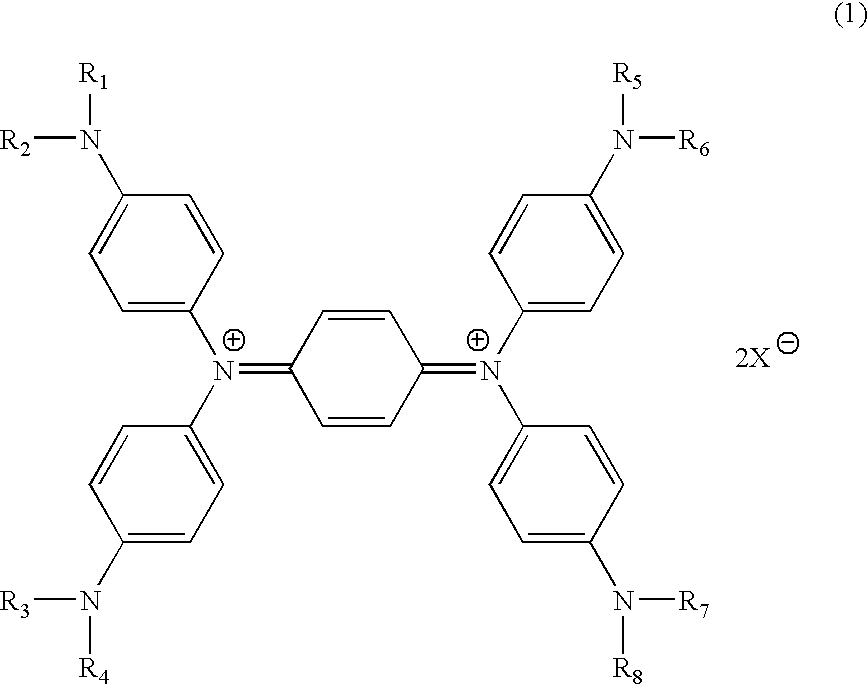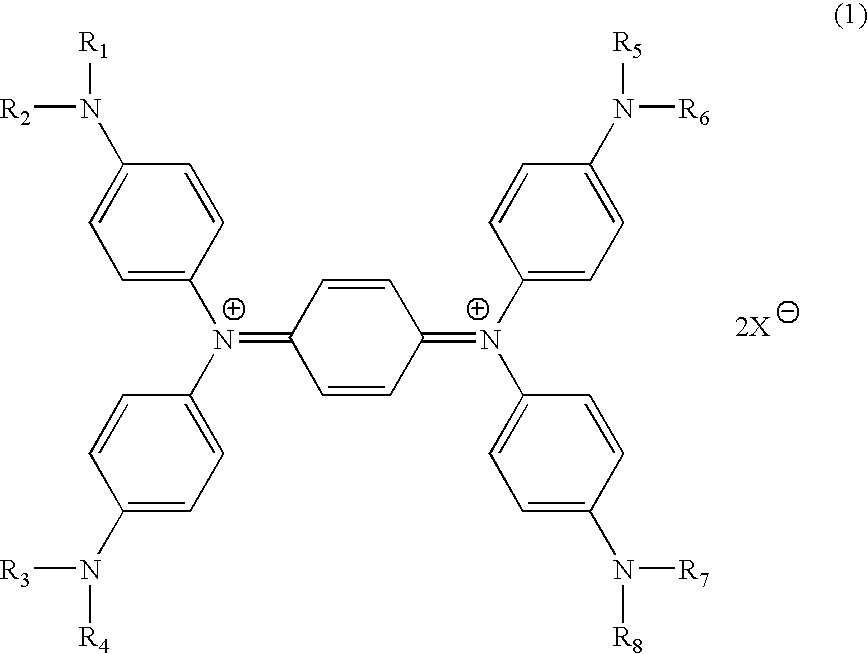Near-infrared absorbing film and optical filter for plasma display panel using the same
a plasma display panel and near-infrared absorbing film technology, applied in the field of optical films, can solve the problems of -infrared rays, low red light color purity, and inability to meet the requirements of the user, and achieve convenient laminates, good heat resistance or stability, and good near-infrared absorbing performance or optical properties.
- Summary
- Abstract
- Description
- Claims
- Application Information
AI Technical Summary
Benefits of technology
Problems solved by technology
Method used
Image
Examples
reference example 1
Synthesis of Copolymer 1
[0065]64 parts of butyl acrylate, 32 parts of cyclohexyl acrylate and 4 parts of acrylic acid as monomers, and 100 parts of ethyl acetate as a solvent were introduced into a flask having a volume of 1 L and equipped with a stirrer, a condenser, a temperature sensor and a nitrogen inlet tube, and the mixture was stirred to dissolve. Nitrogen was introduced to adjust the oxygen concentration in the gas phase to 0.1% by volume or less, and then the solution was heated to 70° C. 0.020 parts of azobisisobutyronitrile as a polymerization initiator, dissolved in a small amount of ethyl acetate, was added to the flask, and the resulting mixture was polymerized under heating for 7 hours while the temperature was maintained at 70° C. Thereby, a copolymer 1 of butyl acrylate, cyclohexyl acrylate and acrylic acid was obtained. Methyl ethyl ketone was added to this copolymer, to dissolve the copolymer to a polymer concentration of 25%, and thereby a resin solution was obt...
reference example 2
Synthesis of Copolymer 2
[0066]A copolymer 2 of butyl acrylate, isobornyl acrylate and acrylic acid was obtained by the same method as that used in Reference Example 1, except that 72 parts of butyl acrylate, 24 parts of isobornyl acrylate and 4 parts of acrylic acid were used as the monomers. Methyl ethyl ketone was added to this copolymer to dissolve the copolymer to a polymer concentration of 25%, and thereby a resin solution was obtained. The weight average molecular weight measured by GPC was 1,100,000.
reference example 3
Synthesis of Copolymer 3
[0067]A copolymer 3 of butyl acrylate, 4-t-butylcyclohexyl acrylate and acrylic acid was obtained by the same method as that used in Reference Example 1, except that 64 parts of butyl acrylate, 32 parts of 4-t-butylcyclohexyl acrylate and 4 parts of acrylic acid were used as the monomers. Methyl ethyl ketone was added to this copolymer to dissolve the copolymer to a polymer concentration of 25%, and thereby a resin solution was obtained. The weight average molecular weight measured by GPC was 1,500,000.
PUM
| Property | Measurement | Unit |
|---|---|---|
| Pressure | aaaaa | aaaaa |
| Transparency | aaaaa | aaaaa |
| Sensitivity | aaaaa | aaaaa |
Abstract
Description
Claims
Application Information
 Login to View More
Login to View More - R&D
- Intellectual Property
- Life Sciences
- Materials
- Tech Scout
- Unparalleled Data Quality
- Higher Quality Content
- 60% Fewer Hallucinations
Browse by: Latest US Patents, China's latest patents, Technical Efficacy Thesaurus, Application Domain, Technology Topic, Popular Technical Reports.
© 2025 PatSnap. All rights reserved.Legal|Privacy policy|Modern Slavery Act Transparency Statement|Sitemap|About US| Contact US: help@patsnap.com


